![]()
![]()
![]()
Use LEFT and RIGHT arrow keys to navigate between flashcards;
Use UP and DOWN arrow keys to flip the card;
H to show hint;
A reads text to speech;
61 Cards in this Set
- Front
- Back
|
What arteries supply the brain in most species?
|
Basilar artery and internal carotid artery
|
|
|
What is the Rete Mirabile?
|
Arteries off the Maxillary artery what supply the brain in pigs, cats and ruminants
* also thought to aid in thermoregulation and intercranial BP |
|
|
What arteries make up the Circle of Willis?
|
Rostral Cerebral a
Middle Cerebral a Cd communicating a Cd cerebral a |
|
|
Why is the low pressure system of the CNS clinically relevant?
|
high risk of infections
|
|
|
Where does the venous blood of the CNS empty?
|
Dural sinus
transverse sinus |
|
|
What creates the space of the dural sinuses?
|
dural reflections of the meninges
|
|
|
What is the arterial blood supply to the arteries?
|
Ventral spinal artery
Dorsal spinal artery internal vertebral plexus (venous system in epideral space) |
|
|
What are clinical causes of occlusion of blood vessels in the spine?
|
Fibicartilagenous emboli- pieces of intervertebral disc
Ischemic encephalopathy- thrombosis infarction of middle artery |
|
|
What are meninges and name all 3.
|
Connective tissues membranes that surround the brain and spinal cord.
Dura mater Arachnoid mater Pia mater |
|
|
What are the functions of the meninges?
|
1) Protection, circulation and reabsorbtion of CSF
2) conveys arterial vessels into nervous tissue and returns venous blood to dural sinuses 3) divides cranium into smaller compartments |
|
|
What is Pia mater?
|
The deepest layer of the meninges, denticulate ligament supports the spinal cord
|
|
|
What is Arachnoid mater?
|
Middle layer of the meninges
sub arachnoid space is between pia mater and arachnoid mater and contains CSF |
|
|
What is Dura Mater?
|
Attaches to the arachnoid later by fibroblast layer and makes subdural space
dura mater is well innervated = pain with meningitis Epideral space is between dura and periosteum of vertebrae |
|
|
What can the cerebellomedullary cistern (cisterna magna) be used for?
|
Collection of CSF
use atlantooccipital joint |
|
|
What is the clinical relevance to hematomas occupying dural space?
|
neurological abnormalities
|
|
|
What are dural reflections?
|
reduce movement of brain with in the brain case during sudden/rapid acceleration or deceleration
*falx cerebri -between 2 cerebral hemispheres *tentorium cerebelli- transverse dural reflection between cerebrum and cerebellum |
|
|
What is the ventricular system?
|
fluid filled cavities within the brain stem and cerebrum that are lined with ependymal cells that produce and circulate CSF
*lateral *3rd *4th *Choroid plexus - connects lateral and 3rd |
|
|
What is the pathway of CSF?
|
Lateral ventricle-3rd ventricle-4th ventricle-spinal canal
|
|
|
What is the function of CSF?
|
Water jacket around nervous tissue
maintain ECF composition Centers for CO2 leaves subarachnoid space through dural sinus |
|
|
What is the BBB?
|
barrier for systemic blood and nervous tissue
only lipophilic and gases pass through |
|
|
What is decussation?
|
when nerve fibers cross between centers on opposite sides of the CNS
|
|
|
What is ipsilateral?
|
dealing with same side
|
|
|
What is contralateral?
|
dealing with opposite side
|
|
|
What are the 5 lobes of the cortex of the brain?
|
Frontal
Parietal Piriform Occipital Temporal |
|
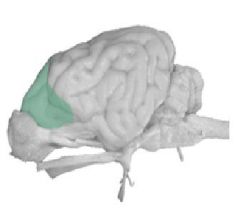
What lobe is this, what does it do and what abnormality is seen due to lesions?
|
Frontal Lobe
somatosensory and motor cortices associated with planning and initiating movement *delay in initiation of contralateral side |
|
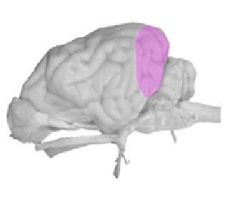
What lobe is this, what does it do and what abnormality is seen with lesions?
|
Occipital Lobe
Perception and innervation of visual information *cortical blindness |
|
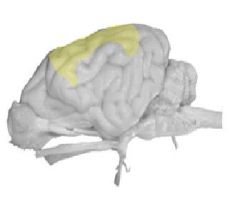
What lobe is this, what does it do and what abnormality is seen with lesions?
|
Parietal Lobe
integrates senesory information to produce a 3D map of body's location *spacial perception problems- hemineglect |
|
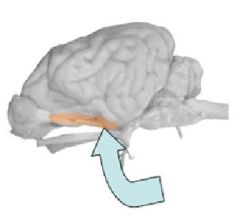
What is this Lobe, what does it do and what abnormality is seen with lesions?
|
Piriform Lobe
perception and interpretation of olfactory (connection to limbic system) *anosmia difficult to detect in incomplete deficit |
|
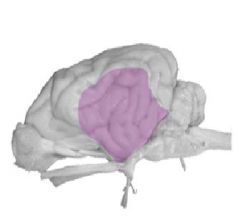
What Lobe is this, what does it to and what abnormality is seen with lesions to this lobe?
|
Temporal
perception and interpretation of auditory information *destruction of both sides of cortex results in deafness |
|
|
What is the Limbic system?
|
not a discrete anatomical lobe of the cortex that links emotion to cortical structures
|
|
|
What are some components of the limbic system?
|
Hypothalamus - homeostatsis
Amygdala - emotional memory Hippocampus - short to long term memory |
|
|
What are some functions of the Hypothalamus?
|
regulator of autonomic functions and basic survival
appetite, thirst, temperature control, circadian rhythms, osmoregulation, visceral motor system |
|
|
What are some functions of the Amygdala?
|
reactivation of emotional response independent of cortical awareness
behavior modification |
|
|
What are some functions of the Hippocampus?
|
converts short term to long term memory and is highly integrated with emotional state
|
|
|
What is consciousness?
|
an individuals ability to perceive its environment and formulate a voluntary response to stimuli
|
|
|
What is ARAS?
|
Ascending Reticular Activating System
receives input from all sensory projection pathways and involved in arousal in the cerebral cortex important in selective attension |
|
|
What are the 5 mental statuses?
|
Alert
Dull Demented -abnormal response Stupor - no response except for pain Coma- no response |
|
|
What is circadian rhythm?
|
variation in physiological rhythms that occur daily
biological clock REM sleep |
|
|
What is Narcolepsy?
|
cerebral disorder resulting in an episodic and sudden onset REM
cataplexy- sudden marked loss of muscle tone |
|
|
What is a seizure?
|
a cortical event characterized by abnormal neuronal discharge which is excessive and hypersynchronized
|
|
|
What is a focus?
|
abnormal area of the brain where seizures originate
kindling spreading of original mirror - contralateral |
|
|
What are the stages of a seizure?
|
Prodrome
Aura ictus Post ictus Interictal |
|
|
What are some classifications of seizures?
|
Partial
Generalized |
|
|
What is the basal ganglia
|
group of nuclei in cerebrum for motor control, cognition, emotion, learning
|
|
|
What is a fovea, foveola, macula?
|
Fovea - area where light rays are optimally focussed asvascular
foveola inner part of fovea Macula = area centralis |
|
|
What is the nasal retina?
|
The contralateral cortex
|
|
|
What is the temporal retinal?
|
The ipsolateral cortex
|
|
|
Where do ganglion cell axons go after they penetrate the optic disc?
|
optic nerve is a tract of the brain not a true nerve
axons of ganglion synapse in LGN the thalamic relay nucleus for vision = 4 visual pathways |
|
|
What are the visual pathways?
|
Retinogeniculostriate
Retinopretectal Retinotectal Retinohypothalmic |
|
|
What is the vision pathway?
|
photo receptor-optic nerve-optic chiasm-optic tract-
1 LGN of thalamus 2 tectal region 3 SCN 4 pretectal |
|
|
What is the vestibular system?
|
system of special proprioception
deals with maintaining a stable orientation in relation to gravity and motion |
|
|
What are the rotational axises?
|
Roll pitch and yaw (x,y,z)
|
|
|
What are the vestibular system receptor organs?
|
Utricle - sensitive to linear acceleration
saccule- sensitive to linear acceleration semilunar ducts - sensitive to angular acceleration involved in motor reflex |
|
|
What is the vestibular pathway?
|
CN VIII to vestibular nuclei in the hind brain
information can go 1)up to and out CN III IV and VI 2) cerebellum to med and lat vestibulospinal tract 3) to the thalamus via thalamocortal pathways |
|
|
What is the organ of corti?
|
contains receptor cells topped with cilia overlaying the tectorial membrane
|
|
|
How to we ear sound?
|
pressure captured by pinna, hit tympanic membrane (vibrates) transfers to the perilymph of the inner ear via the vestibular window, which bend cilia causing depolarization and AP in auditory nerve
perceive frequency and amplitude |
|
|
What is the pathway for sound?
|
cochlear hair cells of CN VIII - cochlear nuclei- cd colliculus
1) startle response 2) MGN of thalamus - temporal lobe- primary auditory pathway |
|
|
What are the two types of deafness?
|
Conduction
Sensorineural |
|
|
What is Conduction deafness
|
Deafness because of blockage before vestibular window
infection, mites, occulsion |
|
|
What is sensorineural deafness?
|
vestibular window can not transmit sound
congenital, old age, drugs, genetic disposition |
|
|
What is Tonotopy?
|
area of the cortex that receive message from different areas of the cochlea and perceive it as pitch
|

